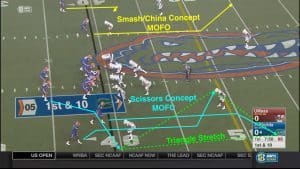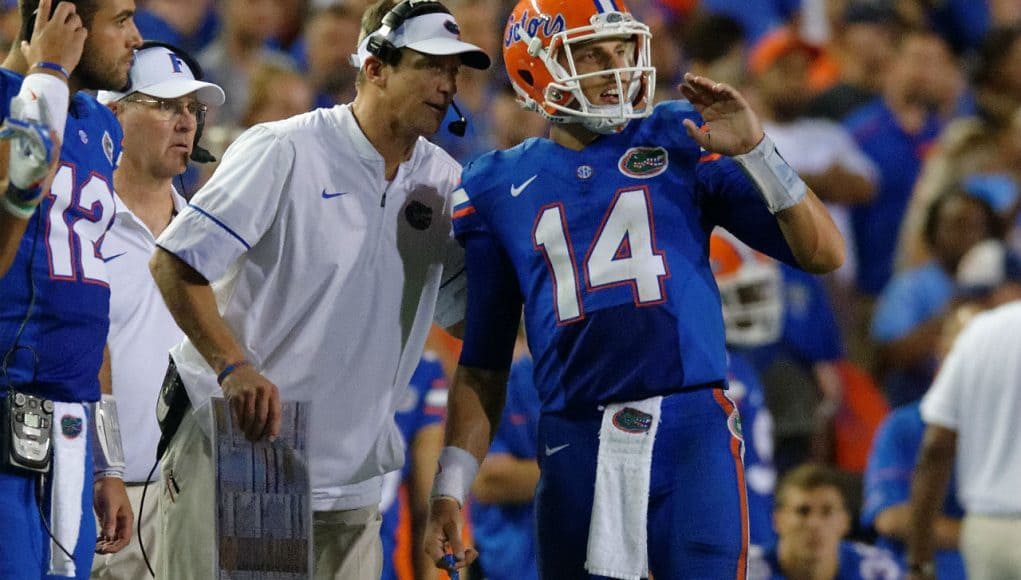Tom Furland brings you his second edition of the “film room” as he breaks down the Florida Gators passing game from last weekend’s game against UMass.
Gator Country will be doing this series throughout the season as Furland breaks down key concepts of the Gators offense.
Dual Concept Passes
Despite soggy conditions in the Swamp, several missing players, a handful of drops, and uninspired play from the offensive line, Florida Gators quarterback Luke Del Rio and the Gator passing offense was effective, though not spectacular. With the Massachusetts defense determined to prevent anything over the top for most of the afternoon, Del Rio worked within the system to amass 256 yards, though requiring 44 attempts to do so. While underneath passes seemed to be the flavor of the day, Del Rio was able to show a few positives that we didn’t see in the back half of last year. Perhaps the two biggest areas were his consistent on-time and in-rhythm delivery of the football when given even a modicum of time to get through his progression, and his willingness to attack the intermediate middle of the field.
Del Rio did this using only a subset of Jim McElwain and Doug Nussmeier’s passing offense, at times running fastball (Mac’s term for the uptempo quick game) and others using a handful of single concept passes out of a few different formations and personnel groupings. The other portion of Coach Mac’s offense that was on display was the dual concept passing game. Like the single concept passing game, the dual concept passing game gets 5 receivers into the pattern and can account for the blitz through built in hot routes. Unlike the single concept passing game, which is a true progression of the entire field, the dual concept passing game is a read of only half of the field and usually doesn’t contain a home run ‘alert’ or a gift read. It is designed to give the quarterback a solid passing concept to either side to deal with multiple possible coverages, but with a very simple key to tell the quarterback what side to read.
This key is whether there is a single high safety or whether there are split safeties. We call those situations ‘Middle of the Field Closed (MOFC)’ or ‘Middle of Field Open (MOFO).’ Simply put, at the snap, the quarterback will look down the middle of the field between the hashes, and if he sees a single safety he’ll read one side, and if he doesn’t he will read the other side. Each side will have a separate concept, with the MOFO side designed to beat cover 2 and 4 shells and the MOFC side designed to beat cover 3 shells and also contain main beaters. Drawn up, they look something like this:

In this case, the Smash concept to the field is a perfect cover 2 beater, designed to provide a high/low stretch on the corner. To the boundary, the scissors concept is actually a combination of 2 quick game concepts: a high low stretch with the corner/shoot routes and a horizontal stretch with the slant/shoot routes. The slant/shoot is also a great route combo against man coverage due to the natural picks that occur and the difficulty in covering a well-run slant man to man, as Brandon Powell can attest to after the completion below. The resulting triangle stretch is a staple of Coach Mac’s offense and will beat almost any form of zone unless the defense over rotates to the triangle side, in which case the slant will come wide open on the field side with what would look like a busted coverage.
Let’s see it in action:
These dual concept patterns are great and versatile patterns that provide multiple answers against modern defenses that can throw a variety of disguises and pressures at a quarterback. They are something Mac often likes to call in third down and fourth down passing situations when you need an answer to several possible challenges from a defense for a chance to move the sticks. It also is another great case of how Mac is able to reduce a 5 man pass pattern into a simple 2 man progression with an outlet and all keyed to the drop of the quarterback. Like Darin Slack’s R4 system, Mac’s single and dual concept passing games don’t just give the quarterback a bunch of routes to read, but teach a systematic way of processing where they should be throwing the ball and when it should come out in order to complete the play in rhythm. It is this teaching methodology that separates Mac and Nuss from the litany of other coaches and passing game gurus out there and enables their quarterbacks to succeed even without the physical gifts some others have. Trust in the system, and you’ll be able to take what the defense gives you consistently, and like Mac says, if you take what the defense gives you enough times, they’ll eventually give you the game.


